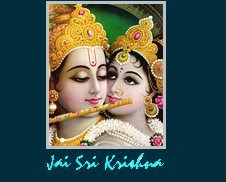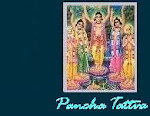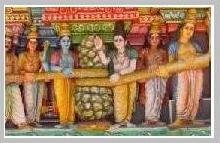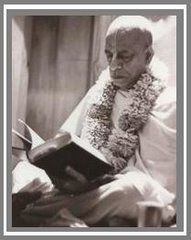 One night Sri Caitanya Mahaprabhu appeared to Gopala Bhatta in a dream and told him to go to the Gandaki River in Nepal and obtain some Shaligram-shilas to worship. Gopala Bhatta Gosvami then went personally to the source of the Gandaki River in Nepal and collected twelve Shaligram-shilas. One of the shalagram was distinctly a Damodara Shalagram. Gopala Bhatta took the shalagrams and placed them in a basket, which he hung on the branch of a tree that was located at the place of the rasa-lila. He worshiped them daily reverentially. Gopala Bhatta would worship these shalagrama-shilas in his place near Nidhivana.
One night Sri Caitanya Mahaprabhu appeared to Gopala Bhatta in a dream and told him to go to the Gandaki River in Nepal and obtain some Shaligram-shilas to worship. Gopala Bhatta Gosvami then went personally to the source of the Gandaki River in Nepal and collected twelve Shaligram-shilas. One of the shalagram was distinctly a Damodara Shalagram. Gopala Bhatta took the shalagrams and placed them in a basket, which he hung on the branch of a tree that was located at the place of the rasa-lila. He worshiped them daily reverentially. Gopala Bhatta would worship these shalagrama-shilas in his place near Nidhivana. Eventually a rich man came and donated dresses and ornaments for the Deities in the temples in Vrindavana. He also donated some dresses and ornaments for the shalagrama-shilas. Gopala Bhatta went to this man and said, “how can I dress my shalagrams with these dresses and ornaments.” He then thought, that he had been very unlucky not to be able to have the darshan and perform further service to Sri Caitanya. He then prayed to Lord Caitanya that you fulfill the desires of your devotees, please give me your bodily darshan, so I can worship you in this form. This happened on the appearance day of Lord Narasimhadeva.
The next morning he saw that a beautiful Deity of Krishna had manifested from the Damodara-shila. His face was like Sri Radha Govinda dev, His chest was like Sri Radha Gopinath, and His legs and feet were similar to Sri Radha Madana Mohan. Gopala Bhatta gave this attractive Deity the name Radha Raman.
Gopala Bhatta went to the Gandaki River in Nepal. During this time he went to a village near Haridwar named Devaban. He was invited into the house of a brahmana. The son of this brahmana, named Gopinatha, later came to Vrindavana. He was initiated by Gopala Bhatta and he was placed in charge of the Deity worship of Radha-Raman. He did not marry and remained a life-long celibate. Gopala Bhatta asked Gopinatha to get married, so his family could continue the worship of Radha-Raman. Gopinatha requested that he not get married and that his younger brother, named Sri Damodar Das, would continue the Deity worship. This family line from Sri Damodar Das has continued to worship the Deity of Radha-Raman in an unbroken chain, up to this day.
There are about 40 Gosvami families connected to the Radha-Raman temple.
Sri Sriman Madhva-Gaudeshwar-Vasihnav-achraya Padmanabha Gosvami Maharaj, a leading priest of the Sri Radharaman temple lineage of Goswamis, who trace their ancestry to Sri Gopala Bhatta, a close disciple of Lord Sri Caitanya Mahaprabhu. His grandfather Sarvabhaum Madhusudan Gosvami, who was known as a distinguished preacher and a Vaishnava scholar, met both Bhaktivinoda Thakur and Srila Bhaktisiddhanta Saraswati Gosvami. He met Bhaktivinoda Thakur in 1906 and 1912, and Bhaktisiddhanta in 1911. He wrote in his diary on September 6, 1911: “Sri Vimala Prasad Siddhanta Saraswati (Srila Bhaktisiddhanta Maharaja) today came at night, 9 pm. Ramananda Babaji was also present. Very intimate thoughts were viewed and discussed.” On September 7 he wrote: “At night we heard the voluminous writings by Sri Vimal Prasad, the writings very much appealed to us.” On the 22th of December in 1914 he sent the maha-prasada of Radha-Raman to Srila Bhaktisiddhanta Gosvami, who at that time was doing the installation of Bhaktivinoda Thakur’s samadhi.
His holiness Padmanabh Goswami maharaj's grandfather met both Bhaktisiddhanta Maharaja and A.C. Bhaktivedanta Swami Prabhupada. H.H Padmanabh Goswami’s father, Viswambhar Gosvami, was considered one of the main scholars of Vrindavan. Srila Prabhupad was very closed friend of Sri Vishambhar Goswami. When Srila Prabhupada came to Vrindavan in 1971, with a group of his disciples, the Vrindavan municipality honored Srila Prabhupada and his Western disciples with a formal reception at the town hall. Sri Vishambhar Goswami was the First Mayor of Vrindavan town. Sri Viswambhar Goswami gave the opening talk at this time in glorification of Srila Prabhupada.


















